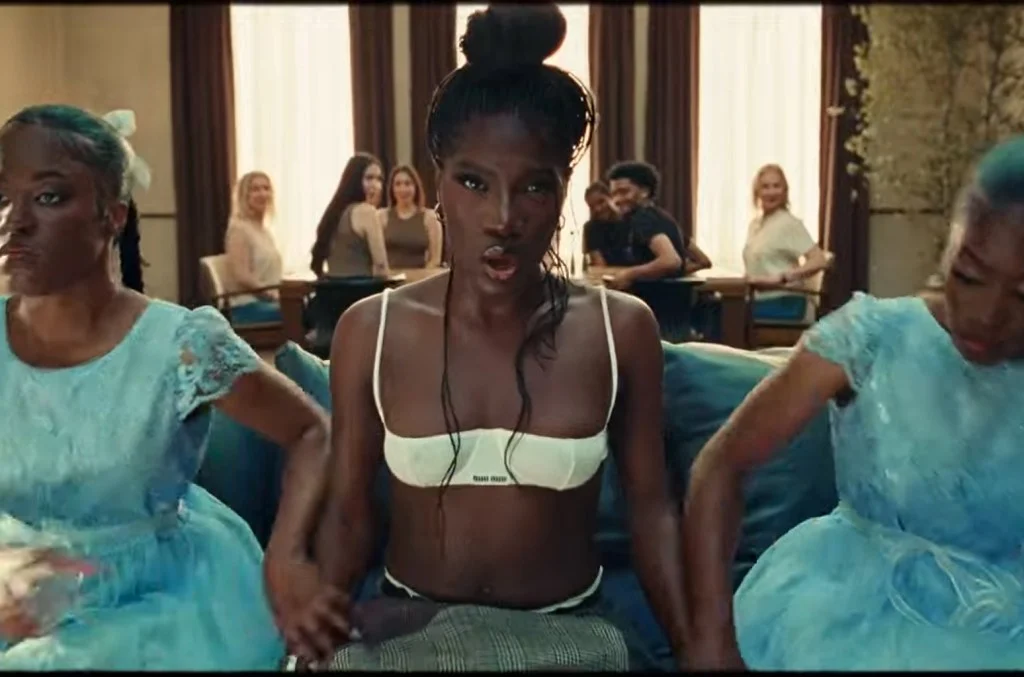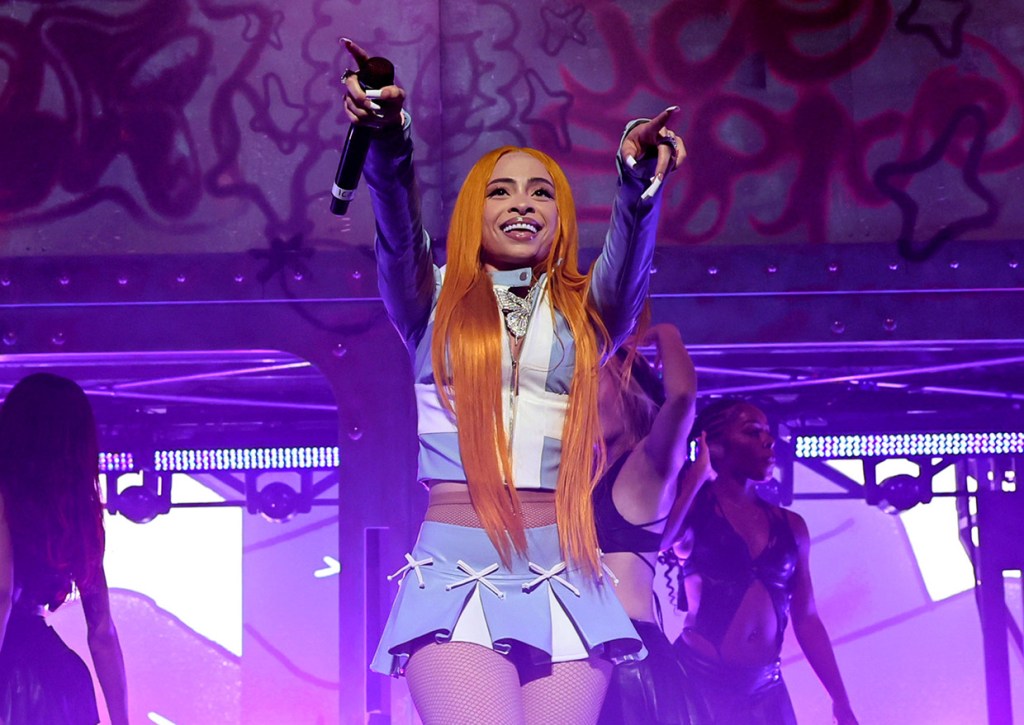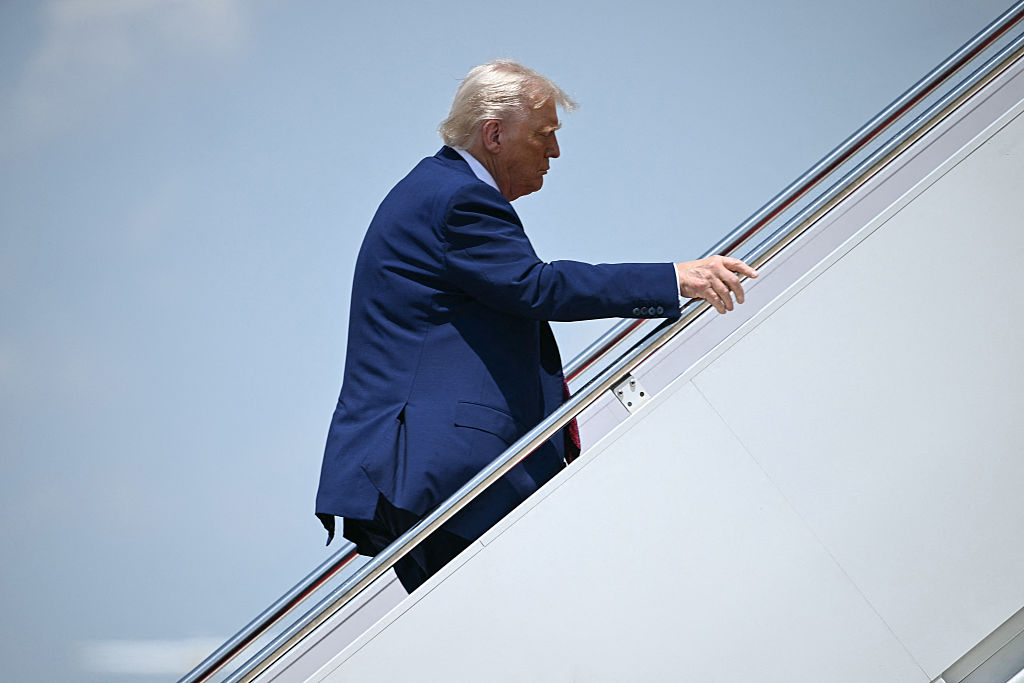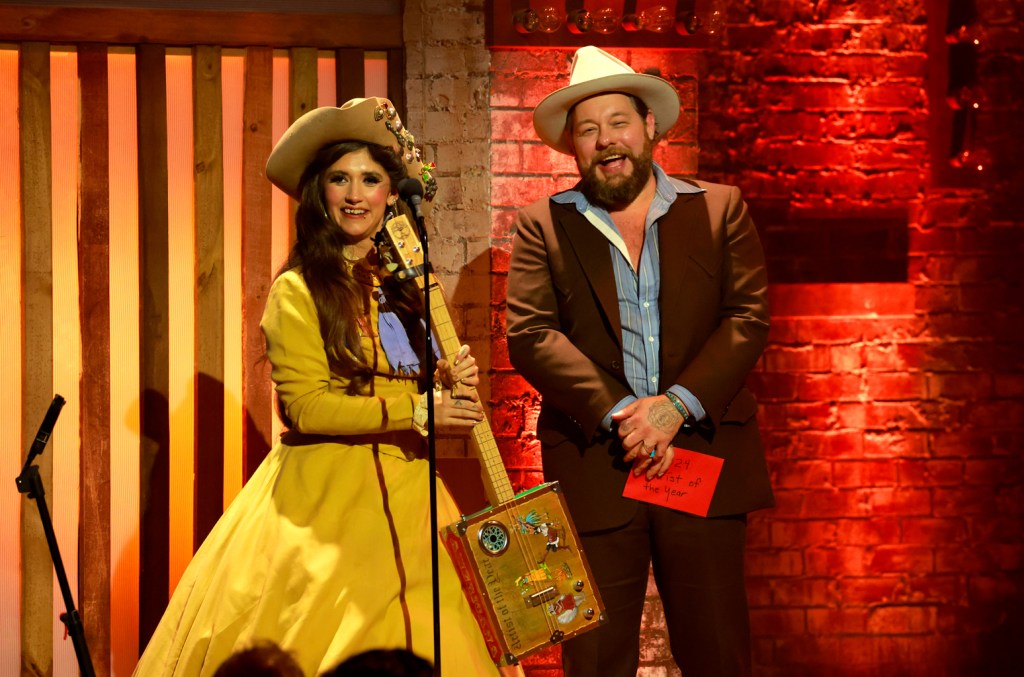News
Page: 296
15 years ago, Wiz Khalifa solidified his mixtape legacy with the release of Kush & Orange Juice, and he returned with a sequel to the classic project earlier this year. Explore Explore See latest videos, charts and news See latest videos, charts and news The Pittsburgh native traveled to the NPR offices to make his […]
All products and services featured are independently chosen by editors. However, Billboard may receive a commission on orders placed through its retail links, and the retailer may receive certain auditable data for accounting purposes.
Teyana Taylor took the stage as a sultry robot at the 2025 BET Awards held Monday night (June 10).
Taylor got the crowd jumping, performing her new single “Long Time” off of her highly-anticipated album Escape Room set to release in August of this year. Beyond her fembot-esque ensemble, the singer’s makeup was on point thanks to the work of makeup artist Yeika Glow who utilized products all from MAC Cosmetics.
Teyana Taylor getting her makeup done for the 2025 BET Awards on June 9, 2025 in Los Angeles.
MAC Cosmetics
“This look was inspired by Teyana’s next era and coming back with her new album. Being part of the creative process of her new awakening: softer girl vibe, but still strong. That couldn’t align with a better brand than MAC,” Glow said in a press release in regards to the makeup look she created. “We were able to focus as artists on telling a story through her look, rather than focusing our time mixing 4 shades of foundation because not all brands cater to brown skin. From the red MAC lip she has worn time and time again, to her own collab with the brand, we are here today to celebrate being soft but strong.”
Explore
Explore
See latest videos, charts and news
See latest videos, charts and news
In honor of Taylor’s crowd-pleasing performance and makeup, we’re giving you the inside scoop into the star’s makeup routine. We’ve picked out the best of the best MAC products Taylor used that you can shop now on the brand’s website and through Ulta Beauty.
Trending on Billboard
MAC Prep + Prime Natural Radiance in Shade Radiant Pink
A luminous primer that makes the skin look hydrated and glowy.
Taylor and her team prepped her skin for the big night with MAC’s Prep + Prime Natural Radiance in the shade Radiant Pink. This product offers a “glow from within” kind of vibe, featuring a gel consistency and luminous pink pigments that glide right on to give the skin a healthy sheen. Designed for all skin types, this product features hydrating ingredients like glycerin and various plant extracts like rosemary and chestnut to boost hydration while the pearlized pigments bring the shine factor.
MAC Studio Fix Powder Plus Foundation in Shade NC38
A finishing powder and foundation all in one compact.
Following her primer, Taylor’s makeup team used MAC’s new Studio Fix Powder Plus Foundation in the shade NC38, a cool-toned bronzy shade with peachy undertones. This product is a two-for-one, working as a setting powder and foundation. The powder foundation offers the skin a blurring matte finish boasting up to 12 hours of wear.
MAC Extra Dimension Skinfinish in Shade Glow With It
A pressed powder highlighter with a glowing finish.
To get Taylor’s glow, her makeup team used MAC’s iconic Extra Dimension Skinfinish in the shade Glow With It. This formula is jam-packed with finely milled sparkling pigments that offer the skin a buildable to blinding glow with one swipe. The cream-to-powder formula is also budge-proof, wearing for up to 10 hours.
MAC Lipglass Air Non-Sticky Lipgloss in Snobbish
A glassy bubblegum pink lip gloss.
The “Maybe” singer’s glossy lips were thanks in part to MAC’s Lipglass Air Non-Sticky Lipgloss in shade Snobbish, a bubblegum pink hue. This gloss comes in 10 different shades on Ulta Beauty, including a clear formula. No matter the shade, the Lipglass smooths out fine lines on the lips while nourishing thanks to a 7% hydrating blend of pure botanical oils, including coconut, jojoba and meadowfoam seed.
MAC MACStack Elevated Mascara
An ultra-black mascara that lengthens and fluffs up lashes.
This mascara was used on Taylor’s lashes to give her a voluminous finish, making her eyes look dark and striking for her performance. The mascara features an argan oil-infused formula that delivers an instant lash lift without clumping for up to 36 hours of wear. This formula is also smudge, sweat and humidity-proof, meaning it could easily withstand Taylor’s strenuous performance.
MAC Lip Pencil in Shade Cork
A muted golden brown lip pencil with a creamy but budge-proof formula.
Taylor’s lips were defined with help from MAC’s Lip Pencil in the coveted shade Cork, a muted golden brown hue that glides on the lips for a precise finish. You can use these pencils to shape, define and fill in to create the perfect pout for you. The lip pencil is formulated with synthetic wax that gives the pencil a subtle stiffness and staying power so you can overline without worry of transfer.
MAC FIX+ Setting Spray
A hydrating fine mist setting spray that locks makeup in place.
To set her look in place, Taylor’s team used MAC’s iconic FIX+ Setting Spray. A tried and true for many, this setting spray hydrates with a fine mist that locks makeup in place for up to 12 hours. The formula is non-drying because it’s alcohol-free, consisting mainly of moisturizing and soothing ingredients like vitamins, minerals, green tea, chamomile and cucumber extracts.
Doechii’s “Anxiety” entered its third-straight week at No. 1 on Billboard’s Radio Songs chart on Monday (June 9) after spending a total of 12 weeks on the Billboard Hot 100, where it peaked at No. 9. But the song, which samples of Gotye’s “Somebody That I Used to Know,” isn’t just a megahit for the Florida singer and rapper.
Billboard estimates that the publishers of the Belgian-Australian indie rocker Gotye and the Brazilian born jazz-pop artist Luis Bonfá — whose 1967 hit “Seville” is sampled in “Somebody” — could earn as much as $72,000 each from the success of “Anxiety.”
Trending on Billboard
“Sampling is a big business,” says Michael Poster, chair of music acquisitions and financing at law firm Michelman & Robinson, LLP. When an old hit is revived through a sample, both the masters and publishing rightsholders stand to earn a cut; the publisher becomes a co-owner of the new song; and the old song will likely see an uptick in streaming activity and synch opportunities, industry sources say.
Doechii’s “Anxiety,” Gotye’s “Somebody” and Bonfá’s “Seville” have all seen “a significant increase… in popularity and consumption” since the March release of Doechii’s hit, says Pär Almqvist, CEO of Sweden-based publishing administration company AYO.
As of Monday (June 9), “Anxiety” has generated nearly 1.2 million song consumption units in the United States, where it has racked up nearly 165 million total on-demand streams and roughly 284,000 airplay spins, according to Luminate.
Billboard estimates that those streams, spins and sales of Doechii’s “Anxiety” have generated about $1.165 million in master recording and publishing revenues combined so far this year.
It is unclear exactly how much Gotye directly stands to earn from that amount, but “Anxiety” credits three songwriters: Jaylah Ji’mya Hickmon, or Doechii; Walter André De Backer, or Gotye; and Bonfá.
DMG Clearances, which secured consent from the copyright holders of “Somebody That I Used to Know” for Doechii’s team, declined to comment on the terms of the licensing deals, citing confidentiality.
Deborah Mannis-Gardner, owner/president of DMG Clearances, says that because “Anxiety” lifted directly from the original recording of “Somebody” to incorporate it into a new song, DMG secured consent from both the master and publishing rightsholders. (Songs that interpolate, rather than sample, earlier hits only need to get consent from the publishing side.)
Mannis-Gardner says that sampled songs see twofold benefits: First, the publisher gets an ownership stake in the new song, thereby increasing the size of its catalog. Additionally, fans of Doechii’s “Anxiety” may find their way to streaming Gotye’s “Somebody,” which could then lead them to “Seville” — and both of those songs are likely to field synch inquiries.
Poster and Mannis-Gardner both say that in typical sample deals, the publisher owns a percentage of the copyright to the new song. Industry sources say it is also typical that publishers will negotiate a one-off, non-recoupable licensing fee of at least a few thousand dollars in addition.
If, as one-third co-writers, Gotye’s and Bonfá’s publishers negotiated 30% of the songwriting credit for “Anxiety,” that could result in nearly $72,000 each to Gotye and Bonfá’s publishers, with Gotye and Bonfá netting anywhere from $36,000 to almost $68,000, if they own their own publishing and have administration deals, Billboard estimates.
Industry sources say Gotye’s and Bonfá’s publishers’ likely got smaller cuts than that. However, what the artists stand to earn from the streaming and synch bumps to their catalogs, though harder to calculate, will also add to their bottom line.
“A sample elevates and increases the value of a song,” Mannis-Gardner says. “But keep in mind, music licensing, including sampling, is an emotional business. Approvals, denials and sample values are not based on a rate sheet. It is how the sampled copyright holder and creator feel about the new use.”
Ice Spice is taking a trip to Bikini Bottom soon, with the rapper officially securing her spot in an upcoming SpongeBob Squarepants movie. Per Deadline, Paramount Animation and Nickelodeon Animation announced on Tuesday (June 9) the new cast for the upcoming film The SpongeBob Movie: Search for Squarepants. Spice was announced alongside Regina Hall, Sherry […]
It’s been a week and a half of celebration for Swifties, following Taylor Swift‘s May 30 announcement of her triumph in buying the masters of her early catalog — six full-length albums and various assorted other releases — back from private equity firm Shamrock Holdings.
Explore
Explore
See latest videos, charts and news
See latest videos, charts and news
The news that Swift’s back catalog was now entirely hers also came with her revelation that while the superstar singer-songwriter had already finished all of her expected Taylor’s Version re-recording of her 2006 self-titled debut album, the final of her first six albums to be re-recorded — 2017’s Reputation — was still less than a quarter complete. Though the long-anticipated Taylor’s Version of that fan favorite does not appear to be coming anytime soon, all news is good news when it comes to Swift’s streaming fortunes — and indeed, her entire catalog got a boost from the recent headlines, led by Reputation bounding from No. 78 to No. 5 on the Billboard 200 albums chart.
How surprising is that Reputation jump? And what could be the next event to send Swift’s catalog screaming back up the charts? Billboard staffers answer these questions and more below.
Trending on Billboard
1. Taylor Swift’s Reputation rebounds from No. 78 to 5 on this week’s Hot 100, following her announcement that she had reacquired her masters. On a scale from 1-10, how surprised are you by this chart surge for the album?
Hannah Dailey: I would say 4. It’s not surprising at all to me that Reputation is the album fans immediately flocked to after the acquisition announcement, given how much anticipation there had been for Rep TV over the past few years. But I am a little surprised that it climbed as far as it did, because a 73-spot leap is insane.
Josh Glicksman: At best, a passing “Huh, how about that?” level of surprise, which equates to a 2 or maybe a low 3. Sweeping gains for Taylor Swift at any point, for any reason, should not really floor anyone who has been keeping tabs on the Billboard charts for the past two decades, particularly in the streaming era. Combine her massive announcement with the ever-growing anticipation of Reputation’s rerelease — and the comfort among her fan base to now resume listening to the original album — and a Billboard 200 that is relatively stagnant, and the runway was wide open for this sort of thing.
Jason Lipshutz: A 2. Taylor Swift buying back her masters was enormous news in the pop world, activating a fan base at a rare moment of (relative) downtime for the superstar. Her entire catalog received a streaming surge, but naturally, Reputation received the biggest bump, after years of Swifties waiting for Reputation (Taylor’s Version); that day may never come now, but with Swift regaining ownership of her fiercely beloved 2017 album, the streaming party was on, and Reputation enjoyed a predictably huge rise back into the top 10 of the Billboard 200.
Danielle Pascual: Honestly, 1. Since her first re-recorded album, Fearless (Taylor’s Version), dropped in April 2021, Reputation (Taylor’s Version) seems to have always been what fans have been the most excited for. I vividly remember that before Midnights was announced at the 2022 MTV VMAs, theories flooded Twitter/X about “clowning for rep tv.” And that was two albums (and two Taylor’s Versions) ago! It is one of her most iconic eras, and now that she owns it, it makes total sense to me that her fiercest supporters — who’ve boycotted those first six albums since Taylor posted that original letter in 2019 — have flocked back to it.
Andrew Unterberger: 1. A friend asked on Friday for my prediction of where it would re-chart and I answered “top five,” so.
2. Most of the rest of Swift’s albums catalog also gains this week, with four of her albums even re-entering the Billboard 200. Are any of the movers in her catalog this week unexpected to you for how big (or how small) their gains were?
Hannah Dailey: I guess I’m a little surprised that albums like Midnights (up 75-50) and Folklore (up 69-52) shot up as much as they did, since they’re kind of unrelated to the acquisition news. But I’m definitely surprised that both Speak Nows reentered the chart (No. 170 for the original and No. 185 for the Taylor’s Version), while Fearless and Fearless (Taylor’s Version) did not. If I was going to pick between the two, I would’ve predicted more love for Fearless – though as a Speak Now diehard, I’m happy to see it.
Josh Glicksman: I’m slightly surprised at both the original and rerelease of Speak Now not making a larger splash in their reentries on the Billboard 200, but perhaps that’s rooted in my own internal bias towards the album. Additionally, it’s not shocking that fans are still gravitating toward her more recent album releases — particularly given that her chart movement this week is largely driven by streaming activity — but I would’ve expected some of the original versions of her reacquired catalog to overtake their respective rereleases. (The Taylor’s Version of 1989 still outranks the original, No. 61 to No. 73; Red (Taylor’s Version) is No. 147 while the original is not on the chart.)
Jason Lipshutz: I’m a little surprised by the rises of some of the re-recorded albums, like 1989 (Taylor’s Version) moving up 19 spots to No. 61 and Speak Now (Taylor’s Version) re-entering the chart. The news of the recordings purchase was focused on her six original albums, not the Taylor’s Version full-lengths that she began putting out in 2021… but such is the demand for all things Taylor, where, in a scenario in which those original albums get re-embraced by fans, the re-records still get an uptick in listens, too.
Danielle Pascual: I’m shocked that neither Fearless nor Fearless (Taylor’s Version) are on this week’s chart. The former was the album that won Swift her first album of the year Grammy and kickstarted her rise to megastar status, and the latter marked the beginning of Taylor’s re-recording journey. It contains some of her most popular songs — including her first-ever Hot 100 top 5 hits, “Love Story” and “You Belong With Me” — so I at least expected it to enter the chart in some way. On the other hand, I definitely saw a big chart moment for the original 1989 coming (it re-enters at No. 73). I wouldn’t be the first to admit that the OG “Style” is better than the “Taylor’s Version,” although, 1989 (Taylor’s Version) does contain some excellent From the Vault tracks!
Andrew Unterberger: While my “top five” prediction proved right on for Reputation, my “just outside the top 10” prediction for the self-titled album…. not so much. Taylor Swift did re-enter the Billboard 200, but only at No. 64, which is obviously much lower than I expected. I suppose I overestimated the sentimentality around Swift’s debut — and since we actually still may get that Taylor’s Version at some point, maybe fans are still waiting for that moment to dive back in anyway.
3. While Swift admitted she had not yet gotten through much of the Reputation re-recording at the time of her announcement, she also said the re-recording of her self-titled debut had already been completed. Do you think we’ll see the full release of that Taylor’s Version – and if so, about when?
Hannah Dailey: I get the sense that she’s ready to close the door on all things Taylor’s Version and Eras, especially now that she owns all her work. But since she’s already spent all that time and effort re-recording Debut, there’s no reason not to release it, especially knowing how much fans want it. I bet we’ll get it soon, probably by the end of the year – maybe in October to honor the month it originally dropped.
Josh Glicksman: Yes, but I wouldn’t expect it any time soon unless she needs a push in momentum for some reason, which is rarely, if ever, the case with her. I wouldn’t be surprised to see Taylor’s Version of her self-titled album appear in fragments — rerecorded fan favorites that are webstore exclusives and packaged to new releases or vault tracks that arrive just in time to be considered for awards season. At some point, I think it’ll arrive in full, but it might come in drips first.
Jason Lipshutz: “I really love how it sounds now,” Swift wrote about Taylor Swift (Taylor’s Version) when she announced that she had bought back her masters. If that’s the case, there’s no way it’s never seeing the light of day. Next year for the 20th anniversary would make sense, but if we don’t receive a new studio album in 2025, the already-finished re-recorded debut album would be a lovely consolation prize this year.
Danielle Pascual: I am pretty certain we will see Taylor Swift (Taylor’s Version) sometime next year though, as it would be the perfect way to celebrate her debut album’s 20th anniversary.
Andrew Unterberger: October 24, 2026 — or whenever the closest Friday to that anniversary date is. Mark your calendars now.
4. Swiftie fandom is as such that it feels like almost any major development in Swift’s career (or life) leads to major gains in her catalog. What do you think the next such occasion will be for her that may have a similar bearing on her chart movement?
Hannah Dailey: An obvious answer would be that she announces a new album, but I do reckon we’re probably getting close to TS12. Beyond that, it could be anything. Maybe Travis Kelce will propose, and her love-song canon — from most of Lover to “So High School” and “The Alchemy” on Tortured Poets – will get a major boost.
Josh Glicksman: It’s easy to speculate that a long-anticipated, highly-speculated question from a certain NFL tight end could cause such a gain, but the more likely answer to me here is that’ll it come more naturally when she’s gearing up for another album release, be it of fully new material or one of the remaining Taylor’s Versions. But how fun would it be if we got a new single from Swift out of the blue to celebrate her reacquisition of the catalog? All I’m saying is: The song of the summer season is upon us; it’s not too late, Taylor!
Jason Lipshutz: Maybe a major change in her personal life that would cause a huge spike for “Love Story,” with Swifties posting the lyrics “Go pick out a white dress/ It’s a love story, baby, just say ‘Yes’” into infinity? The world is waiting for Swift and Travis Kelce to make an engagement announcement; who knows if it will happen, or happen anytime soon, but if and when it does, I fully expect every romance-related Swift song to explode on streaming services.
Danielle Pascual: It’s hard to imagine any other moment would kickstart gains as major as this. The back-and-forth of Taylor’s masters has been top of mind for both her and her fans since the drama began six years ago, and now that chapter is finally closed. That being said, if she wanted to continue this momentum for her original albums, I think it would be smart to re-release vinyl editions of the originals, whether as some sort of collector’s set or individually. The Record Store Day editions of albums like 1989 and Red are highly sought after for vinyl-collecting Swifties (they go for upwards of thousands on the resale market), and I’m sure the fans would flock to any sort of special re-issues, therefore triggering new gains on the Billboard 200.
Andrew Unterberger: I’ll swipe a prediction from our Charts team’s Trevor Anderson and say that the next big Taylor bump will come when she’s announced as the headliner for a certain February 2026 gig at Levi’s Stadium in California.
5. Since we’re unlikely to get it at this point anyway, what would have been your ultimate dream get for a From the Vault Reputation (Taylor’s Version) track?
Hannah Dailey: Having Charli xcx on a Vault song would’ve been legendary. Charli opened for Taylor on the Reputation Tour, so it would’ve been such a cool full-circle moment to see them reunite for something Reputation-related almost a decade later, especially now that Charli has had so much success with Brat. Charli also could’ve elevated the electro-pop feel Taylor experimented with a lot on the original Rep, and it would’ve been an epic way for both women to put those “Sympathy Is a Knife” feud rumors to bed.
Josh Glicksman: If her latest few singles are any indication, Reneé Rapp feels like she would’ve met the Reputation moment and run with it — so I would’ve loved to get her as an FTV guest collaborator.
Jason Lipshutz: The mash-up between “New Year’s Day,” “Long Live” and “The Architect” is still echoing in my head after seeing it performed at Swift’s final stop on her Eras Tour. I was hoping against hope that we’d get it (or another “New Year’s Day” mash-up) with Reputation (Taylor’s Version), but then again, it’s not so bad that that performance belongs to that singular moment forever.
Danielle Pascual: My number one pick for a collaborator on a From the Vault track is definitely Beyoncé. There were a lot of rumors surrounding a team-up after the two showed up at each other’s concert film premieres at the end of 2023, and it would be awesome to see that come into fruition for a brand new Reputation era track. Beyond that — this is a huge reach, but my dream is for Taylor to re-release Reputation in full as a collab album. I’d want all 15 of the album’s original tracks to have a different feature with only female artists. I can see Doechii doing Kendrick Lamar’s part on “Bad Blood,” Sabrina Carpenter on “Call It What You Want” and Halsey on “Don’t Blame Me.” Also, how full-circle would it be to see Olivia Rodrigo on “New Year’s Day”?! Never say never…
Andrew Unterberger: Many fans might answer this question hoping for a full solo version of “End Game,” without the Future and Ed Sheeran feature appearances. I say go the other way with it: Let’s get a full-on…. well, I don’t think we could ever credibly say “posse cut” about a Taylor Swift-led song, but an extended remix with even more pop star guest verses, anyway. Maybe her Reputation Tour openers Camilla Cabello and/or Charli XCX could’ve added 16 bars? Perhaps they could’ve passed the mic to Florence Welch, a future Tortured Poets supporting player and an obvious influence on some Reputation cuts? And then for the final guest: Would a tell-’em-how-you-feel verse from Justin Timberlake, then undergoing some reputational concerns of his own, have been a great idea or a catastrophic one? Dunno, but I’d certainly be interested to find out the answer.
After having a difficult time on stage at Gov Ball, Hozier has made the decision to postpone two of his upcoming shows as he recovers from a virus. The singer-songwriter announced Monday (June 9) that he would be rescheduling his shows in Camden, N.J., and Ridgedale, Mo., writing on X that he is unable to […]
Margo Price is digging deep into her country music foundations on her new album, Hard Headed Woman, set to release Aug. 29 via Loma Vista Recordings. The project, recorded at Nashville’s RCA Studio A with producer Matt Ross-Spang, marks the first album Price has recorded in Nashville, a city she has called home for two […]
Justin Sullivan /Waymo
Using Waymo in downtown Los Angeles got a bit harder due to the ongoing protests against ICE’s immigration raids.
Spotted on USA TODAY, Waymo has announced it has suspended its service in the downtown Los Angeles area after several of its vehicles were destroyed.
A spokesperson for Waymo said the company was pulling vehicles out of DTLA and would not be providing ride-hailing service to the area “out of an abundance of caution.”
The company decided several videos showing Waymo driverless taxis set ablaze and defaced with anti-ICE and Trump messages hit timelines.
As Expected, Donald Trump Is Abusing His Power
In response, without alerting Governor Gavin Newsom, Cheetoh Mussolini federalized the National Guard, ordering them to put a stop to the protests against Trump’s war on immigration.
Governor Newsom has called Trump’s action reckless and irresponsible, and has already begun the steps to take legal action against the Trump administration.
Signal abuser, and our currenct Secretary of Defense Pete Hegseth added that he is ready to send marines if necessary, basically a move to kiss his dear’ leaders ass.
On X, formerly Twitter, Newsom had plenty to say on the matter.
“U.S. Marines serve a valuable purpose for this country — defending democracy. They are not political pawns. The Secretary of Defense is illegally deploying them onto American streets so Trump can have a talking point at his parade this weekend. It’s a blatant abuse of power. We will sue to stop this. The Courts and Congress must act. Checks and balances are crumbling. This is a red line — and they’re crossing it. WAKE UP!” Newsom wrote on his personal X account.
We only expect these protests to spread across the country as ICE continues to terrorize immigrants on claims that they are “removing dangerous illegal aliens.”
HipHopWired Featured Video
Source: BRENDAN SMIALOWSKI / Getty
President Donald Trump was caught on video tripping on the stairs of Air Force One, prompting several social media jokes.
President Donald Trump nearly took a tumble on airplane steps, and social media called him out along with noting that it wasn’t getting as much coverage as opposed to what happened to former President Joe Biden. On Sunday (June 8), Trump was set to board Air Force One to head to Camp David in Maryland, purportedly to meet “a lot of people, including generals… and admirals.” He also fielded questions about the protests in Los Angeles against the actions of Immigration and Customs Enforcement (ICE) and his move to deploy National Guard troops.
He took more questions, with Secretary of State Marco Rubio at his side before exiting to take the stairs to enter Air Force One. As he climbed the stairs, he tripped and grabbed onto the railing with his right hand before collecting himself and resuming the climb into the airplane. The entire moment was caught on C-SPAN.
The moment immediately went viral online, including a close-up shot of Trump’s profile at the moment he tripped and caught himself. It also led many on social media to take their shots at Trump and Republicans who had consistently mocked former President Joe Biden for his moments of difficulty entering and exiting Air Force One. “Slipping on all them lies he’s saying about Los Angeles.” a TikTok user named MammaMia wrote.
Others also called out the hypocrisy they viewed within media outlets who might brush off Trump’s near-tumble but still obsess over how old former President Biden was. “Life has a funny way of showing you different prospectives after one has harshly judged another,” wrote TikTok user Emi333. Others also noted Rubio seeming to trip as he boarded the stairs for Air Force One, and commented that he might’ve been trying to dilute some of the potential barbs thrown at Trump. And a few social media users called out MAGA supporter Joey Mannarino’s odd defense of the stumble.
HipHopWired Featured Video
CLOSE
Sierra Ferrell, who won artist of the year at last year’s Americana Honors & Awards, is nominated in that category again this year, along with Billy Strings, who won in 2022-23; Charley Crockett, Joy Oladokun and Waxahatchee.
Ferrell is vying to become the second woman to win artist of the year twice and the first to do so in back-to-back years. Brandi Carlile won in 2019 and 2021. For his part, Strings would become just the second artist to win three or more times. The late John Prine won four times.
Trending on Billboard
MJ Lenderman, Charley Crockett, Nathaniel Rateliff & the Night Sweats and Gillian Welch & David Rawlings were each nominated in multiple categories. Lenderman is up for album of the year for Manning Fireworks, song of the year for “Wristwatch” and emerging act of the year. Crockett is up for album of the year for Lonesome Drifter and artist of the year. Nathaniel Rateliff & the Night Sweats are up for album of the year for South of Here and song of the year for “Heartless.” Welch & Rawlings are nominated for album of the year for Woodland and duo/group of the year.
Larkin Poe, which won duo/group of the year last year, is nominated again in that category, as is the 2015 winner, The Mavericks. Jason Isbell, a three-time winner for album of the year, is nominated again this year for Foxes in the Snow.
The 24th annual Americana Honors & Awards will be held on Sept. 10 at the historic Ryman Auditorium in Nashville.
Here’s the full list of nominees:
Artist of the Year
Charley Crockett
Sierra Ferrell
Joy Oladokun
Billy Strings
Waxahatchee
Album of the Year
Lonesome Drifter, Charley Crockett; Produced by Charley Crockett & Shooter Jennings
Foxes in the Snow, Jason Isbell; Produced by Jason Isbell & Gena Johnson
Manning Fireworks, MJ Lenderman; Produced by Alex Farrar & MJ Lenderman
South of Here, Nathaniel Rateliff & The Night Sweats; Produced by Brad Cook
Woodland, Gillian Welch & David Rawlings; Produced by David Rawlings
Song of the Year
“Johnny Moonshine,” Maggie Antone; Written by Maggie Antone, Natalie Hemby & Aaron Raitiere
“Ancient Light,” I’m With Her; Written by Sarah Jarosz, Aoife O’Donovan & Sara Watkins
“Wristwatch,” MJ Lenderman; Written by MJ Lenderman
“Sunshine Getaway,” JD McPherson; Written by Page Burkum, JD McPherson & Jack Torrey
“Heartless,” Nathaniel Rateliff & The Night Sweats; Written by Nathaniel Rateliff
Duo/Group of the Year
Julien Baker & TORRES
Dawes
Larkin Poe
The Mavericks
Gillian Welch & David Rawlings
Emerging Act of the Year
Noeline Hofmann
MJ Lenderman
Medium Build
Maggie Rose
Jesse Welles
Instrumentalist of the Year
Fred Eltringham
Alex Hargreaves
Megan Jane
Kaitlyn Raitz
Seth Taylor

 State Champ Radio
State Champ Radio 








